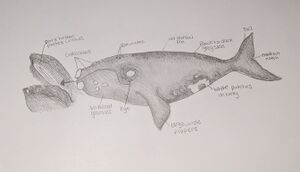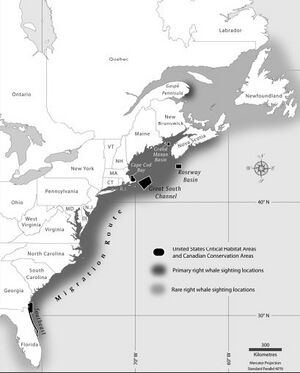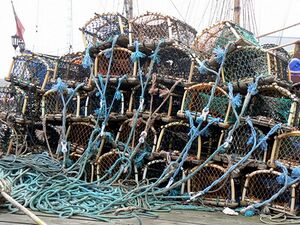Course:CONS200/2023/Saving the endangered North Atlantic Right Whale in the Gulf of St. Lawrence: Strategies and impacts
The North Atlantic Right Whale (NARW) is one of the planet’s most endangered large whale species.[1] This species is listed as critically endangered on the IUCN Red List of Threatened Species.[2] By the early 1890s, commercial whalers had hunted NARWs to the brink of extinction. Since 1935, only 781 different individuals have been sighted, and in 2021, estimated total population size was 340 whales.[1] Other threats include decreased populations of their natural prey, increasing water temperature, and human activity.[1] Due to this serious decline and small population size, there has been increasing interest in providing solutions to challenges hindering the recovery of this species [3].
Description of species
Genealogy
The NARW (Eubalaena glacialis), belongs to the Eubalaena genus. This species is a type of baleen whale[4] which are large aquatic mammals. Baleen whales fall under the order Cetacea and are related to other aquatic mammals such as dolphins and porpoises. The name was given to this species as they float after they are killed, signalling they were the “right” whales to hunt.[4] These whales can live up to 70 years and become sexually mature from between 5-10 years of age. A form of sexual dimorphism is seen in baleens where females tend to be larger than males of the same species.[5]
Phenology
NARWs can grow to nearly 16 metres long, and are capable of weighing 70 tons.[6] These whales have a keratin structure in their jaws known as the baleen plate which is used to capture their food.[4][7] Their skin is dark grey to black and has white splotches around the belly area[4][7]. A large portion of the whale’s body is made up of blubber which stores excess energy and provides insulation from cold temperatures in the ocean. Blubber fat creates buoyancy which makes it easier for whales to surface and breathe through their blowholes.[5] A behaviour called logging is seen in many cetaceans as they rest in a semiconscious state under the water.[5] Major differences between this species and others include the absence of a dorsal fin and throat grooves.[4] One unique feature of NARWs are the white bumps known as callosities surrounding their face. These are used as a medium for their symbiotic relationship with whale lice which is not fully understood at this time.[8] Another organism commonly found living on these mammals is barnacles.
Diet
The baleen plate allows these whales to sift through water to feed. Their diet includes plankton, copepods, krill and schools of fish.[4] These whales skim feed by swimming slowly through clouds of copepods and filtering them out.[4]
Behaviour
NARWs communicate socially similarly to other whales with low frequency noises that have been described as singing. This song is different between populations and can change over time. Socializing occurs at the water's surface and this is also where mating happens.[4] These whales engage in sexual intercourse with multiple different individuals frequently, and have been described as promiscuous breeders. When they give birth after a gestation period of a year, it is usually only to a single calf which is born tail-first.[5]
Habitat
These whales are found in coastal waters in the Atlantic, but can travel long distances.[4] One such populated location is the Gulf of St. Lawrence in Canada. Right whales migrate occasionally and travel alone or in small groups called pods.[4] Food distribution is a large factor in influencing population location and migration.
Whaling History of North Atlantic Right Whales
The oldest evidence of whaling is from findings of a large toggling harpoon made of walrus ivory from the old Bering Sea, suggesting that whaling occurred around 1500 years ago.[9] Right whales were key to the development of the whaling industry in eastern North America, especially in the 18th and 19th century. They were easy to hunt for the following reasons: lack of fear of humans and floatation after death[10]. They also provided large amounts of valuable products such as oil and baleen.[10] The population was reduced to extremely low levels, and was considered commercially extinct in the 19th century. This led to the legal protection of all right whales from commercial whaling in 1935, and additional protection under the International Whaling Commission (IWC) in 1949.[10]
Based on past whaling evidence, the historical range of right whales included a large area of the Atlantic seaboard (coastal areas between Florida in the United States and Labrador in Canada).[11] This also included the Strait of Belle Isle and Gulf of St. Lawrence.[12] The species range was historically believed to have overlapped with bowhead whales. Historic Basque whaling documentation originally suggested that large numbers of each of these species were hunted. However, recent evidence provided by genetic analyses from bones of historic specimens from the 1500s suggests the majority of whales killed through whaling were actually bowheads.[13] As right whales were still very coveted due to the aforementioned values such as oil and baleen, this new evidence proposes that a small population size may be a long-term characteristic of the species.[10] Nutritional limitations are now believed to be one of the leading factors explaining why pre-whaling population sizes were not drastically larger.[10]
Causes of population decline
Studies over the period of the 1990s to the 2010s have shown a steadily decreasing rate in population for the NARW. The population has declined over time due to multiple causes; one such cause is a decrease in their natural prey, copepods. Their prey decreased in population due to the increase in water temperature, until the prey completely moved locations to the Gulf of St. Lawrence. The whales, lacking food, followed their prey and by 2017 there were few to no whales left in their original feeding areas.[14] It was believed that the population would increase with this change; however, the female mortality rate increased instead. The prey population struggles to support the females when they are pregnant or nursing, but is suitable when they are not. This has led to recent predictions estimating the extinction of the NARW in 200 years.[15]
Once the whales fully moved feeding locations, they came under threat from being too close to human activity. In 2017 they were found to have a higher mortality rate due to being hit by boat rudders, entangled in fishing lines, and decreased calf birth rates.[16] Both Canadian and American governments in the areas closest to where the whales were being hurt and killed enforced measures to decrease the rate of injuries for the whales.
Conservation Efforts
Population and Endangerment Status
With an estimated population of 308 in the year 2000, NARW numbers steadily increased to peak at an estimated 481 in 2011.[17] Since then, the population has trended downwards, with estimates placing the number of NARWs in 2021 at 340 ± 7.[1] The greatest decline has been in the population of breeding females, with only 72 remaining as of 2018.[18] Determining exact population numbers is difficult, as only an estimated 36% of total NARW mortalities are documented.[19] In 2017, an Unusual Mortality Event was declared in response to elevated rates of death and injuries amongst the NARW population, with a total of 36 documented mortalities since its declaration.[20]
In 2020, the NARW conservation status was changed from ‘Endangered’ to ‘Critically Endangered’ on the IUCN Red List of Threatened Species.[2] It is listed as ‘Endangered’ in Canada under Schedule 1 of the Species at Risk Act.[21]
Current Conservation Efforts
Most conservation efforts in the Gulf of St. Lawrence focus on reducing vessel strikes and entanglements, as between 2003 and 2018, all documented NARW mortalities with an identifiable cause were attributed to these two hazards.[20][22] To mitigate vessel strikes, Transport Canada has implemented a seasonal closure preventing ships from entering the Shediac Valley in summer months,[23] an area of the gulf where whales amass due to high prey density.[14] There is also a ‘static zone’ with mandated speed limits of 10 knots for vessels longer than 13 meters imposed between April and November, as well as ‘dynamic zones’ with speed limits applied for 15 days following a NARW sighting.[23]
Similar measures have been undertaken by the Department of Fisheries and Oceans Canada (DFO). Non-tended fixed gear fisheries, including lobster and crab fisheries, in a ‘dynamic zone’ will be closed for 15 days if they are within 2000 km2 of a reported NARW sighting;[24] in the Gulf of St. Lawrence, another reported sighting in the 9th to 15th day of that closure will result in the entire area remaining off-limits for the rest of the season. DFO also requires that fishing gear be marked with tracking equipment and reported if lost, so that such “ghost gear” may be removed to lessen entanglement risks.[24]
Future Conservation Directions
Several strategies to reduce deaths and injuries due to entanglements are in the process of being implemented. DFO is providing support to industry trials of “whale-safe” gear, which typically employs weaker ropes that whales can break free from, or is completely ropeless to eliminate risk altogether.[24][25] However, the trial period of this gear before mandatory use was recently extended by DFO to 2024, delaying vital protective measures.[1]
Conclusion
The NARW is a critically endangered species with multifaceted challenges to conservation: as declining prey populations draw the NARW closer to areas of human vessel activities in the Gulf of St. Lawrence, it faces greater threats of vessel strikes and entanglements. Although several federal institutions have put restrictions in place to limit the effects of the transport and fishing industries on the NARW, the population continues to decline and more supportive actions are urgently needed if the species is to recover. Transport Canada and DFO must prioritize programs that reduce risks to NARWs and continue to work closely with scientists and industry workers to develop a multi-pronged approach for conservation of NARWs.
References
- ↑ 1.0 1.1 1.2 1.3 1.4 Pettis H., Pace R., Hamilton P. (2022). "North Atlantic Right Whale Consortium 2021 Annual Report Card" (PDF). North Atlantic Right Whale Consortium.
- ↑ 2.0 2.1 Cooke, J.G. (2020). "Eubalaena glacialis (errata version published in 2020)". The IUCN Red List of Threatened Species.
- ↑ NOAA Fisheries (U.S Department of Commerce). "North Atlantic Right Whale". NOAA Fisheries. Retrieved 12/04/2023. Check date values in:
|access-date=, |date=(help) - ↑ 4.0 4.1 4.2 4.3 4.4 4.5 4.6 4.7 4.8 4.9 "North Atlantic Right Whale". fisheries.noaa.gov. 2022, February 3. Check date values in:
|date=(help) - ↑ 5.0 5.1 5.2 5.3 "Whales". ocean.si.edu. 2020.
- ↑ H., Omura (1958). "NORTH PACIFIC RIGHT WHALE" (PDF). The Whales Research Institute Tokyo Japan.
- ↑ 7.0 7.1 "North Atlantic Right Whale Catalog".
- ↑ Reeb, D. (2007). "Structure of the integument of southern right whales". Anatomical Record-advances in Integrative Anatomy and Evolutionary Biology. 6: 596–613.
- ↑ Powell, Ashley L. (2021). "North Atlantic right whales: 2017-present". Canadian Veterinary Journal. 62: 765–766.
- ↑ 10.0 10.1 10.2 10.3 10.4 Fisheries and Oceans Canada (2014). "Recovery strategy for the North Atlantic right whale (Eubalaena glacialis) in Atlantic Canadian waters" (PDF). Species at Risk Act. Recovery Strategies Series: 79.
- ↑ Reeves, R.R., Mead, J.G., and Katona, S. (1978). "The right whale, eubalaena glacialis, in the western north atlantic". Report of the International Whaling Commission. 28: 303–312.CS1 maint: multiple names: authors list (link)
- ↑ Aguilar, A. (1986). "A review of old Basque whaling and its effect on the right whales (Eubalaena glacialis) of the North Atlantic". Report of the International Whaling Commission. Special Issue. 10: 191–199.
- ↑ Rastogi, T., Brown, M. W., McLeod, B. A., Frasier, T. R., Grenier, R., Cumbaa, S. L., Nadarajah, J., & White, B. N. (2004). "Genetic analysis of 16th-century whale bones prompts a revision of the impact of Basque whaling on right and bowhead whales in the western North Atlantic". Canadian Journal of Zoology. 82: 1647–1654.CS1 maint: multiple names: authors list (link)
- ↑ 14.0 14.1 Gavrilchuk, K., Lesage, V., Fortune, S., Trites, A., Plourde, S. (2021). "Foraging habitat of North Atlantic right whales has declined in the Gulf of St. Lawrence, Canada, and may be insufficient for successful reproduction". Endangered Species Research. 44: 113–136.CS1 maint: multiple names: authors list (link)
- ↑ Greene, C. H. (2004). "Climate and the Conservation Biology of North Atlantic Right Whales: The Right Whale at the Wrong Time?". Frontiers in Ecology and the Environment,. 2: 29–34.CS1 maint: extra punctuation (link)
- ↑ Meyer-Gutbrod, E. L. (2021). "OCEAN REGIME SHIFT IS DRIVING COLLAPSE OF THE NORTH ATLANTIC RIGHT WHALE POPULATION". Oceanography: 22–31 – via JSTOR.
- ↑ Pettis, H., Hamilton, P. (2011). "North Atlantic Right Whale Consortium 2011 Annual Report Card" (PDF). North Atlantic Right Whale Consortium.
- ↑ Reed J., New L., Corkeron P., Harcourt R. (2022). "Multi-event modeling of true reproductive states of individual female right whales provides new insights into their decline" (PDF). Frontiers in Marine Science. 9: 1–12.CS1 maint: multiple names: authors list (link)
- ↑ Pace R. M., Williams R., Kraus S. D., Knowlton A. R., Pettis H. M. (2021). "Cryptic mortality of North Atlantic right whales". Conservation Science and Practice. 3: e346.CS1 maint: multiple names: authors list (link)
- ↑ 20.0 20.1 "2017–2023 North Atlantic Right Whale Unusual Mortality Event". National Oceanic and Atmospheric Association. 2023. Retrieved March 2023. Check date values in:
|access-date=(help) - ↑ "North Atlantic Right Whale (Eubalaena glacialis)". Government of Canada. February 2021. Retrieved March 2023. Check date values in:
|access-date=, |date=(help) - ↑ Sharp, S.M., McLellan, W.A., Rotstein, D.S., Costidis, A.M., Barco, S.G., Durham, K., Pitchford, T.D., Jackson, K.A., Daoust, P.Y., Wimmer, T., Couture, L., Bourque, T., Frasier, T., Frasier, B., Fauquier, D., Rowles, T.K., Hamilton, P.K., Pettis, H.M., Moore, M.J. (2019). "Gross and histopathologic diagnoses from North Atlantic right whale Eubalaena glacialis mortalities between 2003 and 2018". Diseases of Aquatic Organisms. 135: 1–31.CS1 maint: multiple names: authors list (link)
- ↑ 23.0 23.1 Transport Canada. (April 2022). "Protecting North Atlantic right whales from collisions with vessels in the Gulf of St. Lawrence". Government of Canada. Retrieved March 2023. Check date values in:
|access-date=(help) - ↑ 24.0 24.1 24.2 Fisheries and Oceans Canada (December 2022). "2022 fishery management measures: North Atlantic right whales". Government of Canada. Retrieved March 2023. Check date values in:
|access-date=(help) - ↑ Pettis H., Pace R., Hamilton P. (2020). "North Atlantic Right Whale Consortium 2019 Annual Report Card" (PDF). North Atlantic Right Whale Consortium.
| This conservation resource was created by Course:CONS200. It is shared under a CC-BY 4.0 International License. |


